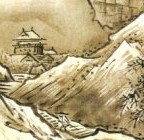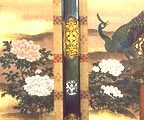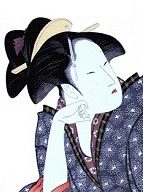 |
Monochrome
ink-wash
Sesshu (1420-1506) was a Zen priest who
travelled to China and although influenced by techniques he saw there
developed his own style of ink-wash that made him the master of Zen
painting.
|
 |
The
Kano school
Founded by Kano Masanobu (1434-1530)
Painting departed from religious themes,
landscapes and animals were now popular and artists decorated the
interiors of palaces and temples built at this time.
|
 |
Ukiyo-e
(from 1640)
'Floating world style' - Art of the coloured woodcut print. This technique
originated in China, first used for book illustrations it then became
an art form in it's own right. Subjects were realistic in style, depicting
the daily lives of people, theatre and places of interest.
In 1842, the depiction of actors and courtesans was banned.
Utamaro print |
 |
Hishikawa
Moronobu
(1618-1694)? |
A highly skilled book
illustrator and producer of erotic prints. One of the founders of
Ukiyo-e. |
Nishikawa
Sukenobu
(1671-1751) |
A painter and book illustrator
of the Kyoto Tosa school. He was noted
for his portrayals of beautiful women. |
Suzuki
Harunobu
(1725-1771) |
Regarded as one of the
most important and commercially successful of the Edo Ukiyo-e painters. |
Shunsho
(1726-1792) |
Founded the Katsukawa
school. A noted painter of actors. He also taught painting to many
including Hokusai. |
Kitagawa
Utamaro
(1753-1806) |
Probably the best known
Ukiyo-e artist. Much of his work depicted sensual women. He was also
imprisoned on a number of occasions for work that seemed critical
of the shogun. |
Katsushika
Hokusai
(1760-1849) |
Another celebrated and
prolific artist. One very successful project was the painting of the
'36 views of Mount Fuji' (c1827). |
Ando
Hiroshige
(1797-1858) |
Well known print maker
of the Utagawa school. He produced many
collections of views, noted are the '53 views of the Tokaido' (1830)
and '100 Famous views of Edo' (1856). |


